![]()
![]()
![]()
Use LEFT and RIGHT arrow keys to navigate between flashcards;
Use UP and DOWN arrow keys to flip the card;
H to show hint;
A reads text to speech;
24 Cards in this Set
- Front
- Back
|
What is Civilization?/ in the case of Mesopotamia? |
*Permanent Settlement *Technological Advancement - irrigation technology, wheel, plow,tools in copper and bronze *Organized Economy -increase of food production, trade, specialization of labor *Organized Government - city states with distinct patterns of social organization (theocratic socialism) *Organized Religion (each city has its patron deity, ruler as god’s earthly steward) -Gods; leaders; and Places of Worship *System of Writing (beginning around 3400-3200BCE, refined into cuneiform) -Record keeping; education; Communication; Literature *Arts, Culture & Traditions (enabled/reflected political power, visual narratives) -Monumental Works; Music; Theater; Painting; Sculpture; methods of preparing food |
|
|
Shift of power in the Mesopotamia region |
Sumerians (4000-2340BCE) > Akkadians >Sumerians >Babylonians >Assyrians >Babylonians (Neo-Babylonia) >Persians
|
|
|
Votive Figure |
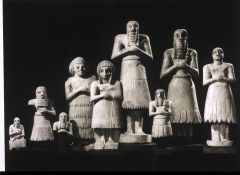
an image created as a devotional offering to a god or other deity. |
|
|
Ziggurat |
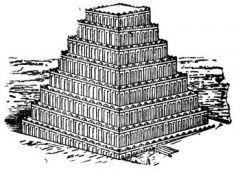
*(in ancient Mesopotamia) a rectangular stepped tower, sometimes surmounted by a temple. |
|
|
Cella |

*the inner area of an ancient temple, especially one housing the hidden cult image in a Greek or Roman temple. |
|
|
Alter |
a table or flat-topped block used as the focus for a religious ritual, especially for making sacrifices or offerings to a deity. |
|
|
Buttress |

*a projecting support of stone or brick built against a wall. |
|
|
Theocratic Socialism |
a form of government in which a deity is officially recognized as the civil Ruler and official policy is governed by officials regarded as divinely guided. |
|
|
Apotropaic Device |
supposedly having the power to avert evil influences or bad luck. |
|
|
Register |
an official list or record, for example of historical places, births... |
|
|
Hieratic Scale |
of or pertaining to priests or the priesthood. |
|
|
Hybrid |
a thing made by combining two different elements. |
|
|
Frontality |
1 sculpture : a schematic composition of the front view that is complete without lateral movement. 2 painting : the depiction of an object, figure, or scene in a plane parallel to the plane of the picture surface. |
|
|
Figure in Profile |
an outline of something, especially a person's face, as seen from one side. |
|
|
Inlay |
ornament (an object) by embedding pieces of a different material in it, flush with its surface. |
|
|
Life-size |
of the same size as the person or thing represented. |
|
|
Sargon |
*flourished c2300 b.c, Mesopotamian ruler: founder of Akkadian kingdom. *Sargon II died 705 b.c, king of Assyria 722–705 |
|
|
What is the narrative depicted on the Stele of Naram-sin |

Victory Stele of Naram-Sin, 2230 B.C.E
*The Victory Stele of Naram-Sin is a relieved depiction of the King Naram-Sin’s victory over the Lullubi people. This narrative story is shown from the view point of King Naram-Sin, giving it a different take on what happened during the battle. |
|
|
Cuneiform |
denoting or relating to the wedge-shaped characters used in the ancient writing systems of Mesopotamia, Persia, and Ugarit, surviving mainly impressed on clay tablets. |
|
|
Inscription |
words inscribed, as on a monument or in a book. |
|
|
Column |
an upright pillar, typically cylindrical and made of stone or concrete, supporting an entablature, arch, or other structure or standing alone as a monument. |
|
|
Sumerian Art |
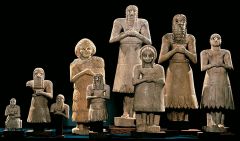
Statues of worshipers from Abu Temple, Tell Asmar Limestone, alabaster, and gypsum, Iraq. ca. 2700-2500 BCE They hold small beakers the Sumerians used in religious rites. The men wear belts and fringed skirts. Most have beards and shoulder length hair. The women wear long robes, with the right shoulder bare. Most striking is the disproportionate relationship between the inlaid oversized eyes and the tiny hands. Because the purpose of these votive figures was to offer constant prayers to the gods on their donors' behalf, the open-eyed stares most likely symbolize the eternal wakefulness necessary to fulfill their duty.
|
|
|
Babylonian Art |
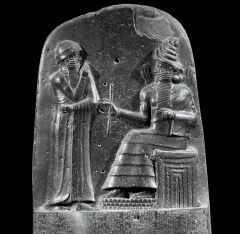
Upper part of stele inscribed with the Law Code of Hammurabi. ca. 1760 BCE *The stele that records Hammurabi's remarkably early comprehensive law code. A relief depicting Hammurabi in the presence of the flame- shouldered sun god, Shamash. The king raises his hand in respect . The god extends to Hammurabi the rod and ring that symbolize authority. The sculptor depicted Shamash in combined convention of front and side views, and explores the notion of foreshortening - a device for suggesting depth by representing a figure or object at an angle. Shamash's beard is a series of diagonal rather than horizontal lines, suggesting it's succession from the picture plane. The bold departure of the register format (normal representational modes) testify the creativity of ancient Near Eastern artists.
|
|
|
Egyptian Predynastic Period |
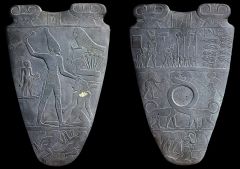
Palette of King Narmer (left, back; right, front), from Hierakonpolis, Egypt, Predynastic, ca. 3000-2920 BCE. Slate, 2' 1' high. Egyptian Museum, Cairo. *These historical reliefs commemorate the unification of Upper and Lower Egypt. Narmer, the largest figure, effortlessly defeats a foe on one side, and on the other surveys the beheaded enemy. The palette, containing some of the earliest hieroglyphic inscriptions ever found, is commonly used in the Predynastic period to prepare eye makeup, in which Egyptians used to protect their eyes from glare and irritation from the sun. At the top of each palette are the two heads of the goddess Hather, divine mother of the pharaoh, who nourishes him with her milk and here takes the form of a cow with a woman's face. Between the Hather heads is a hieroglyph with Narmer's name representing the royal palace. Below that the story of the unification of Egypt unfolds in registers. On the back of th epalette the king, wearing the Upper Egypt crown (high bowling pin shaped) slays an enemy. The falcon, who is Horus the special protecter of the pharaohs, takes a captive man-headed hieroglyph with a papyrus plant growing that stands for the land of Lower Egypt. Below the king are two fallen enemies. The bull symbolizes the king's superhuman strength. Historical narrative was not the artsists goal in this work but the characterization of the king as supreme. |

